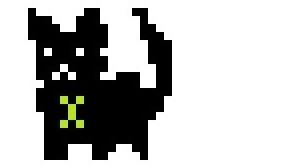Non-fungible. Non-tangible. Still valuable?
Non-fungible tokens (NFTs) are blockchain-based ownership certificates of all kinds of digital collectables—ranging from pixelated cats to canonical YouTube videos and even recordings of unique moments in sport. The market for NFTs has skyrocketed. But what are they exactly? And what is driving their value? With the help of Oxer-cat, the first Oxera NFT, we aim to answer these questions, and provide an overview of possible challenges and future developments for NFTs.
On 22 March 2021, Twitter CEO and founder Jack Dorsey sold his first-ever tweet for more than $2.9m to Malaysia-based crypto-entrepreneur Sina Estavi.1 However, the tweet has gone nowhere: it is still as visible to everyone else as it was before, so what exactly did Mr Estavi buy?
What was sold to Mr Estavi was a blockchain-based ownership certificate called a ‘non-fungible token’—or ‘NFT’. In recent years, NFTs have been at the forefront of news and digital economics discussions. In the first half of 2020, the market for NFTs was already worth $2.5bn, but by the first half of 2021 this market experienced a fivefold increase, to $13.7bn.2 What is auctioned off includes anything from so-called ‘CryptoKitties’ collectables,3 to unique moments in sport,4 canonical YouTube videos (specifically ‘Charlie bit my finger!’),5 a $70m digital art piece,6 and even the original source code to the internet.7
But what are NFTs exactly? And what explains their sometimes astronomical auction prices? In this article, we will try to answer these questions. In order to bring some tangibility to these sometime ephemeral digital constructs, we will be aided by Oxera’s first experimental NFT: Oxer-cat (who, at the time of publishing, is, of course, available to purchase at auction).
Figure 1 Oxer-cat

Source: Oxera.
What are NFTs and how do they work?
NFTs are blockchain-based online-tradeable assets that represent the ownership of any product (digital or physical). More generally, they create a mathematically unique ‘signifier’ of any item in digital space. They are distinct from the copyright ownership of an artwork, and are often sold separately from such rights.
The economics of NFTs is shaped by their unusual characteristics.
- Non-fungibility. Each NFT is unique and is not interchangeable with others. This differentiates NFTs from cryptocurrencies. As similar as two or more NFTs may be to each other, and as similar as the products to which they are linked may be, each one is unique and cannot be traded for another. The Oxer-cat NFT is distinct from all others.
- Scarcity. NFTs are usually scarce in the sense that the number of NFTs relating to a particular physical or digital product is carefully controlled (for example, when an NFT confers ownership of a piece of art, this is often unique). This means that where there are many more interested buyers than there are associated NFTs, very high prices are possible. The Oxer-cat image can be duplicated freely, but there remains only a single associated NFT.
- Indivisibility. NFTs cannot be divided into smaller denominations. It is not possible to acquire half of the Oxer-cat NFT.
- Blockchain-based. NFTs, like crypto currencies, are generally stored on a distributed digital ledger called a ‘blockchain’. A consequence of this is that all transactions are recorded. This ensures that it is possible to verify the authenticity of the NFT and monitor transactions in a decentralised manner. Oxer-cat’s NFT is on the Ethereum Blockchain.
- Flexibility. NFTs can be used to automate contractual or other arrangements concerning the products to which they relate (sometimes referred to as ‘smart’ contracting). This means that transactions can be programmed to ensure flexibility (we discuss this issue in more detail below).
The combination of these characteristics are the origin of the success of NFTs. For example, the reliance on the decentralised blockchain technology allows transactions to be made, and recorded, more quickly. The fact that a record of transactions is kept on the blockchain allows the NFT chain of ownership to be traced back to the creator. In this way, NFTs can help to facilitate trust in the associated transactions; they ensure that the seller cannot deny or dispute that the transaction took place, or take back the NFT once it has been sold without the buyer’s agreement.
Moreover, the flexibility of transactions ensured by NFTs allows the creator and the buyer to, for instance, agree on a commission that the former would earn for every future sale of the NFT. Consequently, NFTs could automate a stream of future earnings generated from the resale of the NFT that would otherwise require reporting of future sales to be included in an enforceable way in the contract of sale. For example, it would be possible for the Oxer-cat NFT to be constructed in such a way that 10% of any future transaction value would be transferred to its creators, though the creators have not done this.
Alongside the example of digital art, possible usages include, for instance, in-game items, documents,8 GIFs, videos, music, virtual avatars,9 and real-world assets. More generally, any item that is digital in nature (or that can be digitalised) can be an NFT.
NFTs also allow real-world objects to be traded straightforwardly, even outside of their natural environment and without the need to take physical possession of the item, as long as the community that makes up the blockchain network recognises the transaction as valid. For example, it is possible to sell the ownership of a physical painting through the transfer of the NFT without necessarily shipping it to the buyer. This is not completely new, as gold reserves, for example, can be traded without the need for them to leave the vault, while artworks in a museum can be sold without moving them. However, NFTs can, in principle, put the trading of real and digital objects on a more equal footing, allowing each to be exchanged in a verifiable way with minimal frictions.
Taken as a whole, the market for NFTs is growing rapidly. As noted above, the market grew more than fivefold between the first half of 2020 and the first half of 2021, soaring in value from $2.5bn to $13.7bn.10 This growth in value was accompanied by a growth in the number of buyers (66%) and sellers (24%).11 More recent data estimates that a total of 85,787 NFTs were traded daily in May 2021, with a corresponding value of $5.8m.12
What is happening to NFT prices?
So what is driving this huge increase in the market for NFTs, and—more specifically—what determines the price of a particular NFT?
NFTs are usually sold through auctions on one of several platforms. These platforms match buyers and sellers of NFTs and include, for instance, OpenSea.io (where Oxer-cat is currently up for auction), Rarible, and Foundation.13 When a transaction occurs, it is registered on a blockchain, with the Ethereum blockchain being the most actively used. As the transaction is registered on the blockchain, there is a consensus within the community that the ownership has indeed been transferred, irrespective of the platform where the transaction actually takes place. The permanence of the blockchain then also guarantees the permanence of the digital ownership certificate.
So on the question of how NFT prices are set, the simple answer is: through demand and supply, with buyers and sellers meeting on these two-sided platforms and deciding prices through an auction process. However, this does not yet answer the question why any particular NFT gets sold for a particular price. We still do not know how much we can expect Oxer-cat to sell for, for instance. This is because while NFT supply is usually fixed (at least in respect of a particular object or artwork), the determinants of NFT demand remain a subject of debate.
Most real-world products have a particular use case from which their demand is derived (whether it is the food that you eat, the house that you live in, or the holiday that you book). Even artwork or videogame-related items—products that now increasingly have NFTs representing their ownership—have a practical use in, for instance, their aesthetic or practical value. However, in the case of many NFTs, the practical use or tangible benefit is not immediately clear: digital art, canonical YouTube videos, and Oxer-cat may have varying entertainment or historic value to different consumers, but they can also be easily shared and viewed by anyone. You do not need to be the NFT owner to see or watch the artwork in question.
To understand what may drive demand in the case of NFTs (and hence their price), we can turn to behavioural economics. By studying how humans actually behave, we ascertain the following potential explanations of rising prices despite a lack of exclusivity in terms of viewing the underlying digital collectable.
- People attach a value not just to simply viewing, for example, a digital artwork, but to the inherent sense of ownership of a piece of art (even if they may not physically possess it) or a piece of internet history.
- The scarcity of the NFT plays an important role not just in ensuring that the same demand chases less supply (which drives up the price), but also in driving up the demand by generating a ‘fear of missing out’. Due to the uniqueness of each NFT, potential buyers perceive it as scarce and, in turn, assign a high value to it.
- One other aspect is linked to the possibility of reselling an NFT, or having rights associated with it (for instance, in terms of a cut on future transaction prices). In this context, the imperfect information and uncertainty regarding future opportunities of monetisation can also push up prices. Put another way, people want an NFT because they expect that other people will want NFTs in the future, allowing for sales revenue. When prices increase rapidly, this can be a powerful demand driver.
Considering these alternative behavioural drivers for demand, one may be tempted to conclude that the prices paid for NFTs are clearly divorced from any tangible or extrinsic driver of utility underlying them. Certainly, NFTs have many of the characteristics needed to create price bubbles, in the sense that an increase in NFT prices can induce an increase in demand divorced from any inherent increase in the NFT value, which in turn induces more price increases. To the extent that the winners of NFT auctions are not those who value the underlying asset or artwork the most, but are the most optimistic about its future value, the so called ‘winner’s curse’ may apply. Due to imperfect information and uncertainty, the optimism may not be well founded, and the buyers can eventually incur a loss.
This all raises the question: are NFTs simply overpriced?
The difficulty of rationally setting an NFT price based on some extrinsic utility, combined with recent news coverage and the incredibly high sums paid for them, has indeed led commentators to think that we might be in an unsustainable bubble.14 However, asset bubbles are notoriously difficult to identify—and even if one were to correctly identify one, it remains notoriously difficult to predict when or how quick it may deflate.
For instance, according to Nonfungible, an NFT market-tracking website, NFTs already saw overall sales shrinking from a seven-day peak of $176m in May to $8.7m in mid-June. This pattern of steep price increases followed by a fall may indicate the end of a bubble. However, it could also simply be interpreted as the market stabilising itself.15 And even if prices are in part driven by unsustainable behavioural drivers such as excessive optimism regarding future opportunities and the winner’s curse, this does not preclude the presence of sustainable drivers such as the inherent sense of ownership or actual future use cases—even if they are not completely clear to us right now. Economics simply cannot yet tell us what the ‘correct’ value of an NFT is.
What next? The future of NFTs
The unstable and uncertain prices of NFTs raise some difficult policy questions. For instance, there is very little regulated consumer protection. Transactions and ownership is registered on the blockchain for all to verify. However, people may still find ways to sell the digital ownership to an asset that they do not actually own, or to manipulate the perceived value of certain NFTs. As in the fine art world, some forms of fraud will remain a concern,16 and as in conventional financial markets, forms of market manipulation may arise. Platforms trading in digital art are not currently subject to the same protections as platforms selling equities, though the risks for retails investors may be seen as comparable.
Another difficult question has to do with the significant carbon footprint linked to the reliance of most NFTs on the Ethereum blockchain.17 Putting NFTs on the Ethereum blockchain and verifying the transactions still requires real-world energy to execute. By one estimate, the carbon footprint of the Ethereum blockchain is currently 27Mt of CO2.18 For comparison, this is about 1% of the EU’s total carbon footprint. The Ethereum blockchain and others recognise this issue and are in the process of developing technical solutions to reduce energy use,19 and will come under increased pressure to ensure that these are implemented across the relevant communities.
Consumer protection and environmental concerns are likely to bring more regulatory scrutiny to the way NFTs are created, bought and sold. Taking these emerging practical issues together with ephemeral and potentially speculative pricing dynamics, it is easy to see why scepticism about the sustainability of NFT value is so widespread among those more used to valuing the tangible. As Christie’s auctioneer Charles Allsopp noted: ‘The idea of buying something which isn’t there is just strange […] I think people who invest in it are slight mugs, but I hope they don’t lose their money’.20
It is too early in the development of the market for NFTs to ascertain whether such scepticism is justified. NFTs have found early adoption in the field of digital art and artefacts, but may find many digital wider applications in the future. The exchange of digital items for money is already commonplace in many platforms: books on Kindle, games on Steam, songs on Spotify, digital pets on Roblox, and weapons on Fortnite provide examples. Ownership of these digital items is managed in a closed and centralised way that limits or at least complicates interoperability, and makes continued ownership and enjoyment of those items contingent on the continued operation of the associated platforms. NFTs provide an open and secure standard that would, in principle, allow the link between the ownership of the item and the platform or software providing access to it be weakened.
Consider, by way of example, a set of NFTs that conferred on an individual a permanent right to view a set of films, which could then be streamed through any participating service. The application of NFTs to such ‘semi-fungible’ items is still in its infancy, but represents a use case in which the smart contracting elements of NFTs could have great commercial potential. For example, in the case of films, there could be a right to sell on such rights (as DVDs used to be sold) subject to a transfer fee payable to the original seller, or bonus access rights for owners of NFTs for a complete series of films, creating an incentive to ‘collect them all’. The viability of such ‘mass-market’ application of NFTs and the willingness of firms and consumers to embrace these NFTs may well be determined by the perceived success (or otherwise) of NFTs in their current niche of digital collectables.
On this point, we turn again to the internet’s source code, to the first ever tweet, to ‘Charlie bit my finger!’, and to Oxer-cat. For a generation of ‘digital natives’ used to the internet’s many bounties being transient and shared, NFTs have a sense of permanence and collectability that should perhaps not be underestimated. We invite the reader to consider how much they would pay for a unique token that confirms them as sole owner of these or other digital artworks and artefacts. Certainly, the market evidence suggests that this is a question that a rapidly expanding number of buyers are asking themselves—and for many, the answer is rather a lot.
As long as there is an internet, the Oxer-cat NFT will outlive its creators, and it could be yours. The auction is open, and bidding has now started, at the price of only 0.001 Ethereum.
1 Lyons, K. (2021), ‘Jack Dorsey’s first tweet sold as an NFT for an oddly specific $2,915,835.47’, The Verge, 22 March.
2 Howcroft, E. (2021), ‘NFT sales volume surges to $2.5 bln in 2021 first half’, Reuters, 6 July.
3 See: https://www.cryptokitties.co/ (accessed 20 July 2021).
4 Howcroft, E. (2021), ‘Andy Murray’s Wimbledon NFT fetches $178k at auction’, Reuters, 6 July.
5 Rosenblatt, K. (2021), ‘“Charlie Bit My Finger” YouTube video sells as NFT for $760,999’, NBC, 24 May.
6 Christie’s (2021), ‘Beeple’s opus’, accessed 20 July.
7 Sotheby’s (2021), ‘Thus Changed Everything: Source Code for WWW x Tim Berners-Lee, an NFT / Lot 1’, accessed 20 July.
8 Ethereum (2021), ‘Non-fungible tokens (NFT)’, accessed 20 July.
9 Conti, R. and Schmidt, J. (2021), ‘What You Need To Know About Non-Fungible Tokens (NFTs)’, 14 May.
10 Howcroft, E. (2021), ‘NFT sales volume surges to $2.5 bln in 2021 first half’, Reuters, 6 July.
11 Harrison, J. (2021), ‘Non-Fungible Token Market Grew by 299% in 2020’, The Fintech Times, 15 February.
12 Sherman, E. (2021), ‘After The Hype: The Future For NFTs’, Forbes, 30 May.
13 Conti, R. and Schmidt, J. (2021), op. cit.
14 Wintermeyer, L. (2021), ‘NFTs Combat Bubble Burst Claims As Real Life Use Cases Push Forward’, Forbes, 29 April.
15 Browne, R. (2021), ‘NFT s Browne, R. (2021), ‘NFT sales are dropping but believers still see a future for digital collectibles’, 15 June.
16 Stephen, B. (2021), ‘NFT mania is here, and so are the scammers’, The Verge, 20 March.
17 Calma, J. (2021), ‘The climate controversy swirling around NFTs’, The Verge, 15 March.
18 Digiconomist (2021), ‘Ethereum Energy Consumption Index’, accessed 20 July.
19 For example, Ethereum’s ‘Eth2’ project visions includes the statement that ‘Ethereum needs to be better for the environment. The technology today requires too much computing power and energy’. See: https://ethereum.org/en/eth2/ (accessed 20 July).
20 Charles Allsopp, quoted in BBC (2021), ‘What are NFTs and why are some worth millions?’, 12 March.
Download
Related

Road pricing for electric vehicles: bridging the fuel duty shortfall
Governments generate significant revenue from taxes on petrol and diesel, which has been essential in financing and maintaining infrastructure. These taxes are also intended to incorporate the externalities of driving, such as congestion, noise, accidents, pollution and road wear. If these costs were borne by society instead of by drivers… Read More

Spatial planning: the good, the bad and the needy
Unbalanced regional development is a common economic concern. It arises from ‘clustering’ of companies and resources, compounded by higher benefit-to-cost ratios for infrastructure projects in well developed regions. Government efforts to redress this balance have had mixed success. Dr Rupert Booth, Senior Adviser, proposes a practical programme to develop… Read More

